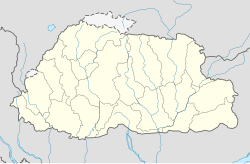| Paro Taktsang | |
|---|---|
 View of Paro Taktsang | |
| Religion | |
| Affiliation | Tibetan Buddhism |
| Sect | Nyingma and Drukpa Kagyu |
| Deity | Guru Padmasambhava |
| Location | |
| Location | Paro Valley, Paro District, Bhutan |
| Country | Bhutan |
| Geographic coordinates | 27°29′30.88″N 89°21′48.56″E / 27.4919111°N 89.3634889°E |
| Architecture | |
| Style | Bhutanese |
| Date established | 9th century (as a meditation cave) 1692 (formally built as a monastery) |
Paro Taktsang (Dzongkha: སྤ་གྲོ་སྟག་ཚང་, also known as the Taktsang Palphug Monastery and the Tiger's Nest),[1] is a sacred Vajrayana Himalayan Buddhist site located in the cliffside of the upper Paro valley in Bhutan. It is one of thirteen Tiger's Nest caves in historical Tibet in which Padmasambhava practiced and taught Vajrayana.[2]
A later monastery complex was built in 1692 by 4th Druk Desi Tenzin Rabgey around the Taktsang Senge Samdup cave, where Guru Padmasambhava meditated and practiced with students including Yeshe Tsogyal before departing the kingdom of Tibet in the early 9th century.[2][3] Padmasambhava is credited with introducing Vajrayana Buddhism to Bhutan, which was then part of Tibet, and is the tutelary deity of the country.[4] Today, Paro Taktsang is the best known of the thirteen taktsang or "tiger lair" caves in which he and his students meditated.
The shrine dedicated to Padmasambhava, also known as Gu-ru mTshan-brgyad Lhakhang or "the Shrine of the Guru with Eight Names", refers to Padmasambhava's Eight Manifestations and is an elegant structure built around the cave in 1692 by Gyalse Tenzin Rabgye. It has become the cultural icon of Bhutan.[5][6][7] A popular festival, known as the Tsechu, held in honor of Padmasambhava, is celebrated in the Paro valley sometime during March or April.[8]
- ^ Lopen Kunzang Tinley (2008). Seeds of Faith: A Comprehensive Guide to the Sacred Places of Bhutan. Vol. V1. Thimphu: KMT Publishers. pp. 121–130. ISBN 978-99936-22-42-0.
- ^ a b Palden Sherab Rinpoche, Khenchen (May 1992). The Eight Manifestations of Guru Padmasambhava. Translated by Khenpo Tsewang Dongyal Rinpoche. Padma Gochen Ling: Turtle Hill. Archived from the original on 2022-12-04. Retrieved 2022-12-20.
- ^ "The Ultimate Guide to Hiking to the Tiger's Nest, Bhutan".
- ^ "Padmasambhava the Precious Guru of Tibetan Buddhism".
- ^ Ardussi, John A. (1999). "Gyalse Tenzin Rabgye and the Founding of Taktsang Lhakhang" (PDF). Journal of Bhutan Studies. 1 (1). Thimphu: Centre for Bhutan Studies: 28. Retrieved 2010-03-12.
- ^ Williamson, Teresa Rodriguez (2007). Fly Solo: The 50 Best Places on Earth for a Girl to Travel Alone. Perigee. p. 170. ISBN 978-0-399-53310-5. Retrieved 2010-03-12.
- ^ Yowell, Skip (2007). The Hippie Guide to Climbing the Corporate Ladder and Other Mountains: How ... Thomas Nelson. pp. 155–156. ISBN 978-1-59555-852-7. Retrieved 2010-03-12.
- ^ "Things to Know about Tshechu Festival in Bhutan".
